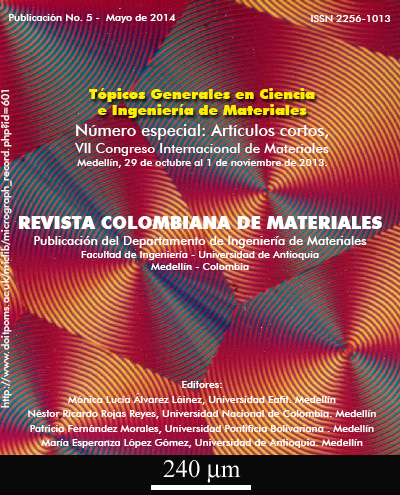.
DOI:
https://doi.org/10.17533/udea.rcm.19442Keywords:
Graphene oxide, adsorption, Langmuir isotherm, Methylene blueAbstract
Downloads
References
MANSILLA, Héctor, LIZAMA, Cristian, Tratamiento de residuos líquidos de la industria de celulosa y textil. Comisión Nacional de Energía, Cap. 13,2010.
FORGACS, Esther, CSERHÁTI, Tibor, OROS, Gyula, “Removal of synthetic dye from wastewaters: a rewiew”, Environment International 30 953-971,2004
GIL, Edison, QUINTERO, Luisa, Degradación de colorantes de aguas residuales empleando UV/TiO2/H2O2/Fe2+, Universidad EAFIT, vol. 43, 2007.
YANG, Sheng-Tao, et al, “Removal of methylene blue from aqueous solution by graphene oxide”, Journal of Colloid and Interfase Science, 359, 24-29,2011.
ZHANG, Wenjie, et al, “Fast and Cosiderable Adsortion of Methylene Blue Dye onto Graphene Oxide”, Bull Environ Contam Toxicol 87:86-90, 2011.
RAMESHA, G.K. et al, “Graphene and grapheneoxide as effective adsorbents toward anionic and cationic dyes”, Journal of Colloid and Interface Science. 361 270-277,2011.
GÓMEZ Iván, “Síntesis y caracterización de grafeno químicamente reducido (CRG), empleando técnicas espectroscópicas y microscopía electrónica de barrido”. Director: Enrique Mejía Ospino. Tesis de pregrado. Universidad Industrial de Santander, Escuela de Química, 2012.
HAMEED, B. H., “Adsorption of methylene blue onto bamboo-based activated carbon: Kinetics and equilibrium studies”, Journal of Hazardous Materials 141 819-825, 2007.
FERNANDES, Andreia, “Isotherm and thermodynamic data of adsorptionof methylene blue from aqueous solution onto peat”, Journal of Molecular Structure 982 62-65,2010.
ZHANG, Zhengyong, “Adsorption isotherms ans kinetics of methylene blue on a low-cost adsorbent from a spent catalyst of vinyl acetate synthesis”, Applied Surface Science 256 2569-2576,2010.








